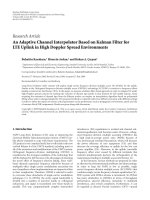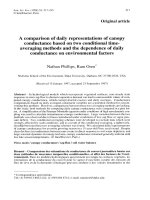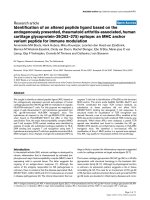Designing an ultra compact triplexer based on two staggered ring resonators using silicon waveguides
Bạn đang xem bản rút gọn của tài liệu. Xem và tải ngay bản đầy đủ của tài liệu tại đây (730.99 KB, 4 trang )
80
Cao Dung Truong, Tran Hoang Vu
DESIGNING AN ULTRA COMPACT TRIPLEXER BASED ON TWO
STAGGERED RING RESONATORS USING SILICON WAVEGUIDES
THIẾT KẾ BỘ TRIPLEXER CỰC NHỎ DỰA TRÊN HAI BỘ CỘNG HƯỞNG VÒNG PHÂN
TẦNG SỬ DỤNG ỐNG DẪN SÓNG SILICON
Cao Dung Truong1, Tran Hoang Vu2
1
Hanoi University of Science and Technology; Email:
2
Danang College of Technology, The University of DaNang; Email:
Abstract - An ultra-compact triplexer is designed by utilizing two
staggered ring resonators that coupled with directional couplers
that based on submicron silicon on insulator (SOI) optical rib
waveguides. Firstly, a ring waveguide is designed to separate the
wavelength 1490 nm in its drop port. A second ring resonator are
utilized for separating the wavelength 1310 nm in drop port and the
wavelength 1550 nm in through port . The total size of the present
triplexer is only 11.5 àmì8.8àm. Numerical simulations with Finite
Differential Time Domain (FDTD) method and effective index
method (EIM) are used for design and optimization the operation
of the triplexer.
Tóm tắt - Một triplexer (bộ tách ghép ba bước sóng) kích cỡ cực
nhỏ được thiết kế bằng cách sử dụng hai vòng cộng hưởng phân
tầng mà được ghép với các bộ ghép trực tiếp trên các ống dẫn
sóng cỡ micron. Các ống dẫn sóng dạng sườn được sử dụng vật
liệu silic trên nền silic ơ xít (SOI). Đầu tiên, bộ cộng hưởng vòng
được thiết kế để tách bước sóng 1490 nm xuống cổng rẽ. Một bộ
cổng hưởng thứ hai được sử dụng để tách bước sóng 1310 nm
xuống cổng rẽ thứ hai và bước sóng 1550 nm được dẫn tới cổng
ra thẳng. Kích cỡ tổng cộng của triplexer ch vo khong 11.5
àmì8.8àm. Mụ phng s vi phng phỏp sai phân hữu hạn miền
thời gian (FDTD) được kết hợp với phương pháp hệ số hiệu dụng
cho thiết kế, đánh giá hiệu năng và tối ưu hóa hoạt động của bộ
tripexer.
Key words - triplexer; ring resonator; directional coupler; SOI
waveguide; FDTD
Từ khóa - triplexer; cộng hưởng vịng; bộ ghép trực tiếp; ống dẫn
sóng SOI; FDTD
1. Introduction
Triplexer plays a very important role in a fiber-to-thehome (FTTH) system. According to ITU G.983
recommendation, three wavelengths are utilized
commonly to be 1310, 1490 and 1550 nm, for upstream
digital, downstream digital and downstream analog
channels, respectively. There are some types of triplexers.
One is to cascade filters such as thin film filters [1] but this
type has a drawback is difficult to integrate with other
optical device so it is expensive. Two is to use gratings e.g.
arrayed waveguide grating (AWR) [2] and Bragg [3]
grating but their size is quite large. The other types are
either constructed on MMI coupler technique [4] or used
planar lightwave circuits (PLCs) such as photonic crystals
[5] or silicon rib waveguide [6]. In there, silicon waveguide
is a promising solution due to some its advantages such as
high contrast refractive index allows for high confinement
of light also high compactness structure with ultra-sharp
bending. Moreover, it is very adaptive with CMOS
technology [7] thus making it cheaper than the others.
Recently, some ring resonators based structures using
silicon waveguide have been proposed, such as WDM filter
[8], modulator [9], all optical switching, etc. Ring or disk
resonators support traveling wave resonant modes. By side
coupling to a signal bus, a single ring may completely
extract a particular wavelength. The communications
window of WDM filters such as the triplexer supported by
erbium amplifiers is 20 nm. Rings with a free - spectra
range (FSR) larger than this would require a radius of 5 µm
or less [8]. Ring resonator based on silicon waveguide with
low loss, high quality factor and small radius only 1.5 µm
has been fabricated successfully [10].
In this paper, we present a novel structure for ultra-
compact triplexer by using two staggered ring resonators
that are coupled with straight directional couplers based on
submicron waveguides. The proposed triplexer composes
the first ring resonator for separating the wavelength 1490
nm in a drop port and the second ring resonator to separate
subsequently two wavelengths of 1310 nm and 1550 nm in
its drop and through ports respectively. Due to FDTD is
most potential numerical simulation method for ring
resonator based structures, so we used the FDTD method
for design and optimization of proposed triplexer.
a)
z
y
Port 3
gr
x
1310 nm
through port
gR
gR
r
R
gr
drop port
1550 nm
b)
w
Port 2
Port 1
1310, 1550, 1490 nm
SiO2: nc=1.46
drop port
1490 nm
Upper cladding
w
(µm)
H
Si: nr=3.45
Core
SiO2: nc=1.46
Cladding
Si: nr=3.45
Substrate
h
Fig 1. Proposed schematic of the triplexer based silicon
waveguide. a) Top-view. b) Cross-section and fundamental
mode of input waveguide.
ISSN 1859-1531 - THE UNIVERSITY OF DANANG, JOURNAL OF SCIENCE AND TECHNOLOGY, NO. 11(84).2014, VOL. 2
Fig 2. FDTD simulation for the transmission characteristic of
the first ring resonator is a function of radius R.
2. Design and Optimization
Fig. 1 shows the configuration of the proposed triplexer
is based on submicron silicon waveguides. Those
submicron silicon waveguides is made by silicon on silica
with upper cladding of silica. Refractive index of silicon
core layer is nr=3.45 and silica cladding layer is nc=1.46.
By using the Sell Meier model, we can get that the
refractive index difference of silicon core layer between
wavelengths 1310 nm and 1550 nm is ∆n≈0.025. Such
difference is very small so we could be negligible in this
design. Hence, in this design, we can consider the
refractive index of silicon as a constant. In this design, the
triplexer is designed for on operation of TE mode. The
width w of the ring resonator and single mode waveguides
is in the range from 160 nm to 560 nm for satisfying the
single mode condition. In this design, we choose w=360
nm. By using the beam propagation method (BPM)
simulation, we found the total thickness of silicon guiding
layer H=0.4 µm and the slab height h = 32 nm so that the
optical field can be achieved maximally when propagating
into the waveguides. Finite element method (FEM)
simulation for fundamental mode is shown in the Fig. 1b).
The proposed structure can be fabricated by using currently
electron beam (EBeam) lithography technology, such as
193 nm deep ultra violet (DUV) EBeam lithography
technology.
Fig 3. FDTD simulation for the transmission characteristic of
the second ring resonator as a function of radius r varies.
Basic operation principle of the proposed triplexer is
present in Fig. 1. There are two sections. The first section
includes a ring resonator and two straight waveguides that
they are coupled with the ring resonator. The first ring
resonator is designed to resonate with the wavelength of
1490 nm, while wavelengths of 1310 nm and 1550 nm are
passed through it. This aims to separate the wavelength
81
1490 nm to port 1 as seen on Fig. 1. The second section
aims to separate wavelengths of 1310 nm and 1550 nm
subsequently to two remaining ports. The design purpose
of the second ring resonator is to separate the wavelength
of 1550 nm to drop port (port 2) and the wavelength of
1310 nm to through port (port 3) as seen on Fig. 1. Hence,
the second section composes a ring resonator are both
coupled commonly bus and staggered with the first ring
resonator so that the optical signal when traveling the
through port of the first ring resonator will resonate with
the wavelength of 1550 nm and pass through the
wavelength of 1310 nm as seen on Fig. 1.
As a presented preliminary, firstly we design a ring
resonator for separating the wavelength of 1490 nm. The
gap gr between straight waveguides and ring resonator is
chosen as gR=35 nm. The radius R of the first ring resonator
is designed so that the first ring resonates with the
wavelength of 1490 nm and it doesn’t resonate with
wavelengths of 1310 nm and 1550 nm. The resonance
condition must satisfy R=pλ1490nm/2πneff, where p is a
positive integer and neff is effective refractive index of the
waveguide. FDTD simulation method has been used in
designing and optimizing the ring resonator which based
on high refractive index contrast nanowire waveguides, the
accuracy of the FDTD simulation for those waveguides is
high enough if the grid sizes are small enough. Based on
the FDTD simulation, we find that to obtain the full
coupling and mode coupling coefficient between the
straight waveguide and ring resonator waveguide
maximally when the gap gR was 35 nm, the radius R should
be in the range from 2 µm to 3 µm. Then, by changing the
value of radius R of the ring resonator following three
wavelengths of 1310 nm, 1490 nm and 1550 nm in the
selected range to find out an optimal value which must
satisfy the conditions: the outputs power at drop port
(λ=1490 nm) and through port (λ=1310 nm and 1550 nm)
are maximal. Result, we chose the optimal value of radius
to be Ropt =2.475 µm (see the marked point in Fig. 2). The
center of the first ring resonator is placed at the position of
3.2 µm in the z-propagation direction.
Next, we consider a second ring resonator for
separating the remaining wavelengths of 1550 nm and
1310 nm. The gap gr between straight waveguides and ring
resonator is chosen by FDTD simulation as gr=22 nm so
that the resonance in the second ring resonator is maximal.
The radius r of the second ring resonator is designed so that
the wavelength of 1550 nm is resonated in the second ring
and the wavelength of 1310 nm is propagated pass through
over commonly bus of two ring resonators. The resonance
condition must satisfy to be: r=qλ1550nm/2πneff, where q is a
positive integer and neff is effective refractive index of the
waveguide. Based on the FDTD simulation, we find that to
obtain the full coupling when the gap gr was 22 nm, the
radius r should be in the range from 2 µm to 2.5 µm. Then
we reuse the FDTD simulation by changing the value of
radius r of the second ring resonator following three
wavelengths of 1310 nm and 1550 nm in the selected range
to find out an optimal value which must satisfy the
conditions: the outputs power at drop port (λ=1550 nm) and
82
Cao Dung Truong, Tran Hoang Vu
through port (λ=1310 nm) are maximal. Finally, we chose
the optimal value of radius to be ropt =2.355 µm (see the
marked point in Fig. 3). The center of the second ring
resonator is placed at the position of 5.4 µm in the zpropagation direction. We choose the length of the straightwaveguide as 8.8 µm which is proper for operation of the
device. Result, the total size of the proposed triplexer is
very small only about 11.5àm ì 8.8 àm.
a)
b)
Fig 5. Wavelength responses of the proposed triplexer
at three ports for thee wavelengths.
a) 1310 nm band. b) 1490 nm and 1550 nm bands.
3. Simulation Results and Discussion
a)
b)
c)
Fig 4. FDTD simulation for electric field distribution in the
triplexer for: a) 1310 nm, b) 1490nm and c) 1550 nm.
Table 1. Output powers (normalized to the input power) of three
output ports of the proposed triplexer at three wavelengths.
Wavelength (nm)
1310
1490
1550
Port1 (dB)
-17.48
-0.22
-17
Port2 (dB) Port3 (dB)
-17.62
-0.2
-17.66
-16.56
-0.68
-17.7
Fig 6. Wavelength dependencies of insertion loss
and crosstalk of the triplexer for:
a) 1310 nm band, b) 1490 nm band and c) 1550 nm band.
ISSN 1859-1531 - THE UNIVERSITY OF DANANG, JOURNAL OF SCIENCE AND TECHNOLOGY, NO. 11(84).2014, VOL. 2
By using the FDTD method, we do simulate the optical
signal propagation for all ports of the triplexer. Fig. 4
presented electric field pattern distribution by FDTD
simulation in the triplexer at three wavelengths of 1310 nm,
1490 nm and 1550 nm respectively. The output powers at
different output ports (normalized to the input power) are
shown on Table I.
Fig. 5 shows the wavelength response of the proposed
triplexer. Because of the high index contrast and smooth
bending of ring resonators, bending loss could be
negligible in this design [8]. From simulation data, the
most importance performance parameters of the triplexer
based on ring resonators such as free spatial range (FSR),
3-dB bandwidth of the resonance (∆λ) and quality factor
(Q) etc. can be easy to obtain. For example, from Fig. 5,
FSR parameters of port1and port2 are about 40 and 40 nm
respectively (due to wavelengths of 1490 nm and 1550 nm
are dropped into port1 and port2 respectively). The 3-dB
bandwidth of the resonance of port1 and port2 are
corresponding to 3.8 and 5.4 nm. These correspond to
quality factors of 392.1 and 287, defined as Q=λ/∆λ. These
quality factors are suitable in comparison with an existing
triplexer [5].
For a triplexer, the most important performances are the
insertion loss (I.L) and the crosstalk (Cr.T), these are
defined as follows:
P
I.L = 10log d
Pin
P
Cr .T = 10log d
Pu
(1)
(2)
Where Pin is the power in the input waveguide, Pd and
ΣPu are corresponding to the power from the desirable
output waveguide and the total power from undesirable
output waveguides.
Finally, Fig. 6 shows wavelength dependencies of
insertion loss and crosstalk of the triplexer. Simulation data
to show that at the level of crosstalk below -12 dB,
bandwidths of port3 (1310 nm band), port1 (1490 nm band)
and port2 (1550 nm band) are about 9.6 nm (from 1301.4
nm to 1311 nm), 0.62 nm (from 1489.6 nm to 1490.22 nm)
and 1.14 nm (from 1549.28 nm to 1550.42 nm),
respectively. These bandwidths of output ports of the
proposed triplexer are also corresponding to the variation
of insertion losses of 0.3 dB, 0.5 dB and 0.5 dB
respectively. The worst case of the bandwidths is the case
of port1. This is explained by the resonance performance
of the ring resonator for the wavelength of 1490 nm is
worst. However, such performances are quite good for
application of the triplexer. Especially, simulation results
showed that the proposed triplexer has low loss.
Nevertheless the optical performances of the proposed
triplexer are better than some published ones realized by
83
planar lightwave circuits in comparison with insertion loss
also about crosstalk [4], [6], [7]. Another highlight
importance is because of very small size of the proposed
triplexer in comparison with recent published ones, [5], [6].
Our triplexer has the total size only 11.5ì8.8 àm2, it is
clearly very appropriate for compactness photonics
integrated circuits.
4. Conclusion
We have introduced a compact triplexer by using two
staggered resonators which coupled directionally with
straight waveguides and it is based on silicon rib
waveguides. The ring resonators are used for
demultiplexing the wavelengths of 1490 nm and 1550 nm.
Insertion losses at three output ports of three wavelengths
are below 0.7 dB so our triplexer has low loss. Simulation
was implemented by using the FDTD to show that the
triplexer has good performances. The total size of the
device is much smaller than some existing triplexers.
REFERENCES
[1] M. Ishii and T. Oguchi, “Low-loss and compact TFF-embedded
silica-waveguide WDM filter for video distribution services in
FTTH systems,” in Optical Fiber Communication Conference, OFC
2004, 2004, pp. 1–3.
[2] Uematsu, Y. Ishizaka, Y. Kawaguchi, K. Saitoh, and M. Koshiba,
“Design of a Compact Two-Mode Multi/Demultiplexer Consisting
of Multimode Interference Waveguides and a WavelengthInsensitive Phase Shifter for Mode-Division Multiplexing
Transmission,” J. Light. Technol., vol. 30, no. 15, pp. 2421–2426,
Aug. 2012.
[3] S. Bidnyk, D. Feng, A. Balakrishnan, M. Pearson, M. Gao, H. Liang,
W. Qian, C.-C. Kung, J. Fong, J. Yin, and M. Asghari, “SOI
waveguide based planar reflective grating demultiplexer for FTTH,”
Proc. SPIE, vol. 6477, p. 64770F–64770F–6, 2007.
[4] J. H. Song, J. H. Lim, R. K. Kim, K. S. Lee, S. Member, and K. Kim,
“Bragg Grating-Assisted WDM Filter for Integrated Optical
Triplexer Transceivers,” IEEE Photonics Technol. Lett., vol. 17, no.
12, pp. 2607–2609, 2005.
[5] T. Shih, Y. Wu, and J. Lee, “Proposal for Compact Optical Triplexer
Filter Using 2-D Photonic Crystals,” IEEE Photonics Technol. Lett.,
vol. 21, no. 1, pp. 18–20, Jan. 2009.
[6] Y. Shi, S. Anand, and S. He, “Design of a Polarization Insensitive
Triplexer Using Directional Couplers Based on Submicron Silicon
Rib Waveguides,” J. Light. Technol., vol. 27, no. 11, pp. 1443–1447,
2009.
[7] H.-H. Chang, Y. Kuo, R. Jones, A. Barkai, and J. E. Bowers,
“Integrated hybrid silicon triplexer,” Opt. Express, vol. 18, no. 23,
pp. 23891–9, Nov. 2010.
[8] B. E. Little, S. T. Chu, H. A. Haus, J. Foresi, and J.-P. Laine,
“Microring resonator channel dropping filters,” J. Light. Technol.,
vol. 15, no. 6, pp. 998–1005, Jun. 1997.
[9] M. Lipson, “Compact Electro-Optic Modulators on a Silicon Chip,”
IEEE J. Sel. Top. Quantum Electron., vol. 12, no. 6, pp. 1520–1526,
Nov. 2006.
[10] Q. Xu, D. Fattal, and R. G. Beausoleil, “Silicon microring resonators
with 1.5-microm radius,” Opt. Express, vol. 16, no. 6, pp. 4309–15,
Mar. 2008.
(The Board of Editors received the paper on 10/03/2014, its review was completed on 01/04/2014)









